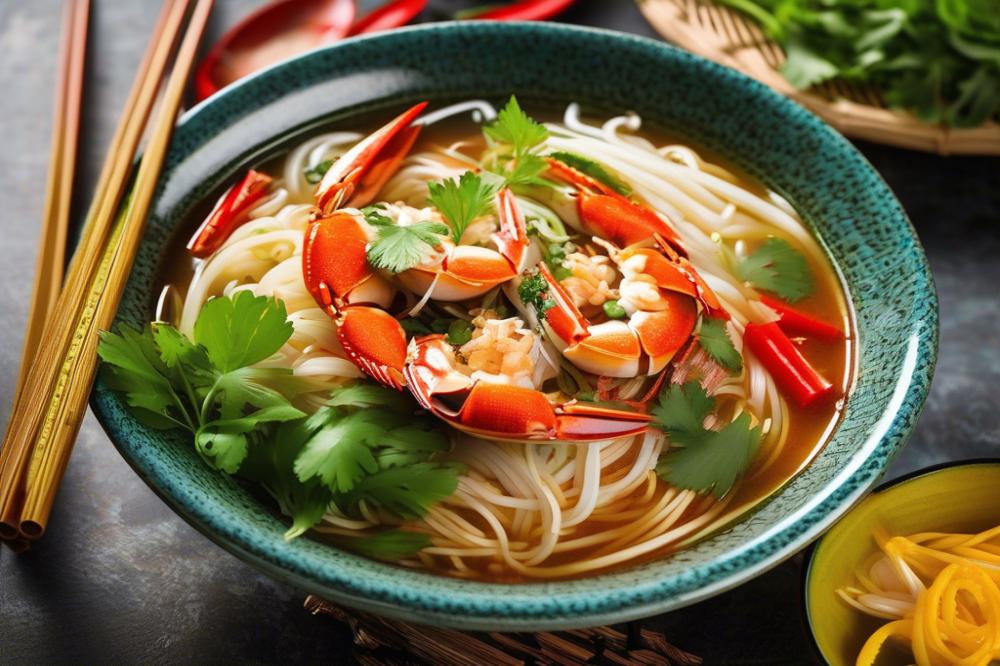Introduction
Bún Riêu Cua is a cherished dish in Vietnamese cuisine. This vibrant crab noodle soup combines fresh ingredients and rich flavors, making it a favorite among many. Originating from the northern regions of Vietnam, it has become a beloved option for those seeking comfort food. Families often enjoy this dish together, especially during chilly days, or when someone is feeling under the weather.
The popularity of this seafood soup is not just because of its taste. Each bowl reflects a part of Vietnamese culture, showcasing the importance of fresh produce and seasonal ingredients. A typical bún riêu recipe highlights the balance between flavors—tartness from tomatoes, sweetness from crab, and the fragrant herbs that finish off the experience. Eating this homemade soup can evoke a sense of nostalgia and warmth, connecting people with their roots.
Unique ingredients define this traditional Vietnamese food. Various types of noodles and a rich broth create a base that is both satisfying and delicious. When cooked, the blend of spices and toppings enhances every spoonful. Cooking tutorials online guide many who wish to learn the art of making this delightful dish. As people search through Asian recipes, this noodle soup stands out for its ability to comfort and please in equal measure.
What is Bún Riêu Cua?
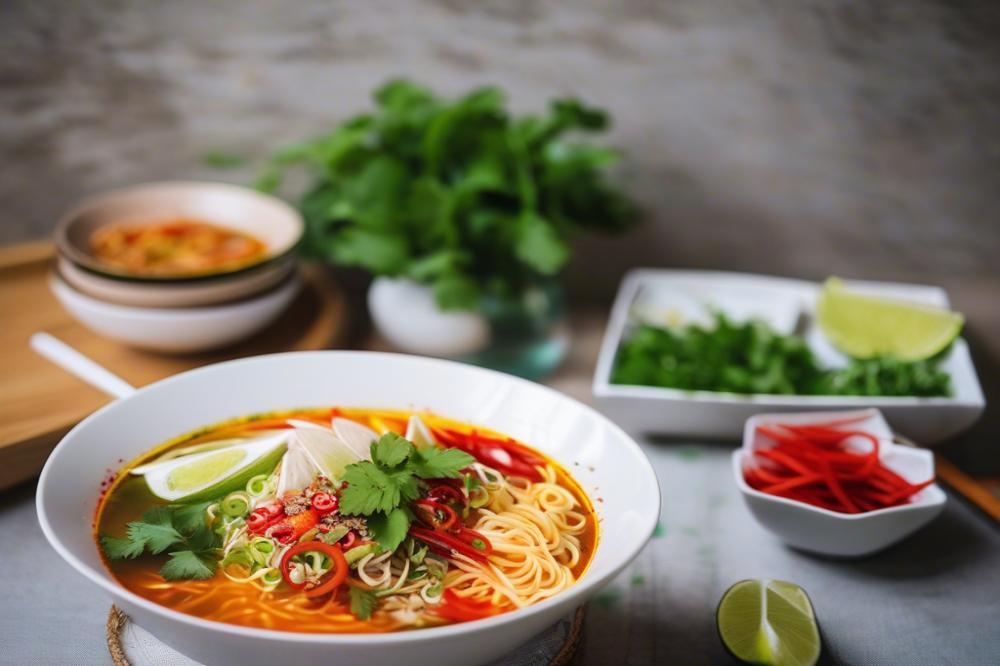
Bún Riêu Cua is a popular Vietnamese noodle soup, celebrated for its rich flavors and vibrant ingredients. This delightful dish is made with rice vermicelli noodles, a flavorful broth, and various toppings. Central to its essence is a crab broth, which provides a seafood taste that is both comforting and refreshing. Typically, the broth features fresh crab, tomatoes, and sometimes other seafood to add depth to the flavor.
The importance of crab broth in this soup cannot be overstated. It serves as the backbone of the dish, infusing every sip with the ocean’s essence. When preparing a bún riêu recipe, using freshly caught crabs enhances the broth’s aroma and taste. Not only does this ingredient highlight the unique characteristics of Vietnamese cuisine, but it also reflects the country’s coastal heritage.
Noodles play a crucial role in the overall experience of this dish. Rice vermicelli offers a light texture that complements the rich broth perfectly. Each strand absorbs the flavor, making every bite a delightful experience. This combination of noodles and crab soup creates a satisfying meal that warms the soul.
Cultural significance is evident in the variations of this dish found across different regions of Vietnam. In the north, you might find a bún riêu that includes fermented tofu, while southern versions often incorporate more seafood. Street vendors may serve their own unique twists, showcasing creativity and local ingredients. Such diversity in preparation shows how traditional Vietnamese food can evolve while still holding onto its roots.
Cooking tutorials for Bún Riêu Cua often emphasize the importance of freshness and balance in flavors. This seafood soup not only nourishes the body but also tells a story of community and togetherness. Across the country, families enjoy this comfort food, sharing their unique takes on the recipe during special occasions.
Ingredients and Cooking Instructions
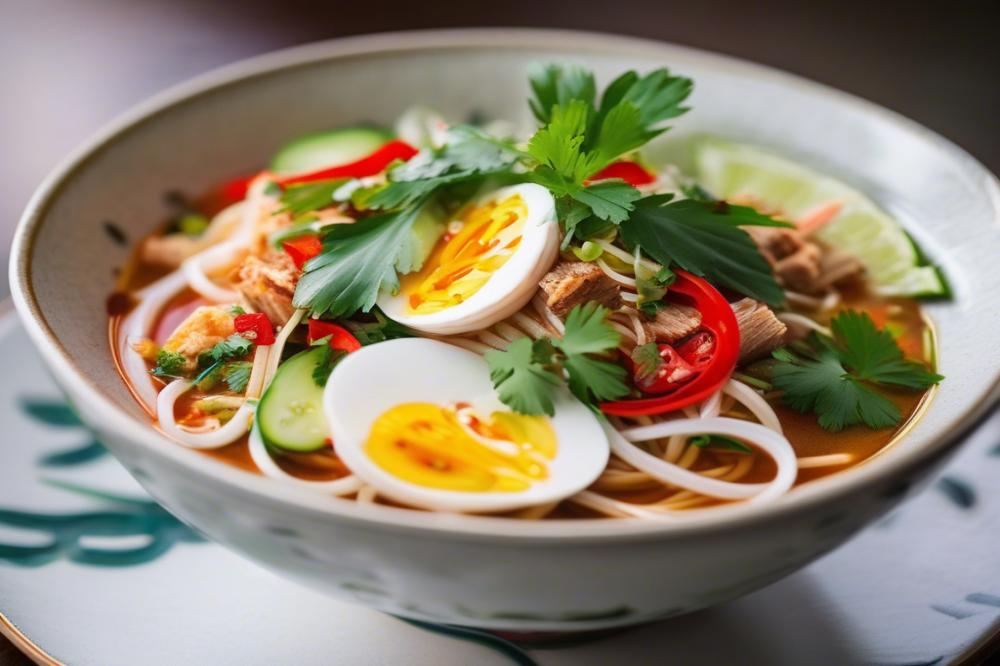
List of ingredients with quantities:
- 500g crabs (preferably fresh blue crabs)
- 200g rice vermicelli noodles (bún)
- 500ml fish stock or water
- 2 medium tomatoes, chopped
- 1 onion, sliced
- 1 teaspoon turmeric powder
- 2 tablespoons tomato paste
- 1 tablespoon shrimp paste (optional)
- Fresh herbs (e.g., mint, cilantro) for garnish
- Bean sprouts, lime wedges, and chili for serving
Step-by-step cooking instructions:
Preparing the crab
Start with the crabs. Clean them thoroughly under running water. If you prefer, you can also boil them for a few minutes to make removal of the shells easier. Crack the shells and extract as much meat as you can. Any leftover shells can add flavor to the broth.
Making the crab broth
To create the broth, place the extracted crab meat and shells into a pot. Add fish stock or water and bring it to a simmer. Toss in the sliced onion, chopped tomatoes, turmeric powder, and the tomato paste. If you like stronger flavors, shrimp paste can enhance the taste. Let this mixture simmer for about 30 minutes to build up all the rich flavors.
Cooking the noodles
While the broth simmers, prepare the rice vermicelli noodles. Boil a separate pot of water. Once the water is at a rolling boil, add the noodles. Cook them according to package instructions, usually just a few minutes. Afterward, drain and rinse them under cold water to stop the cooking process. This keeps the noodles firm.
Assembling the soup with toppings
It’s time to serve. In a bowl, place a generous portion of the cooked noodles. Strain the broth to remove the solid bits. Pour the hot broth over the noodles, ensuring some crab meat makes it into the bowl. Top with fresh herbs like mint and cilantro. Add bean sprouts for crunch and serve with lime wedges and chili on the side. This process brings together the essence of Vietnamese cuisine, creating a delightful comfort food.
Nutritional information for all ingredients:
Here’s a breakdown of the approximate nutritional values for this bún riêu recipe:
- Calories: ~400-500 per serving
- Protein: ~30g (mainly from crab and shrimp paste)
- Fat: ~15g (depends on the type of stock used)
- Carbohydrates: ~60g (mostly from rice vermicelli)
- Vitamins: A good source of vitamin C from tomatoes and lime
Cooking Tips for Perfect Bún Riêu Cua
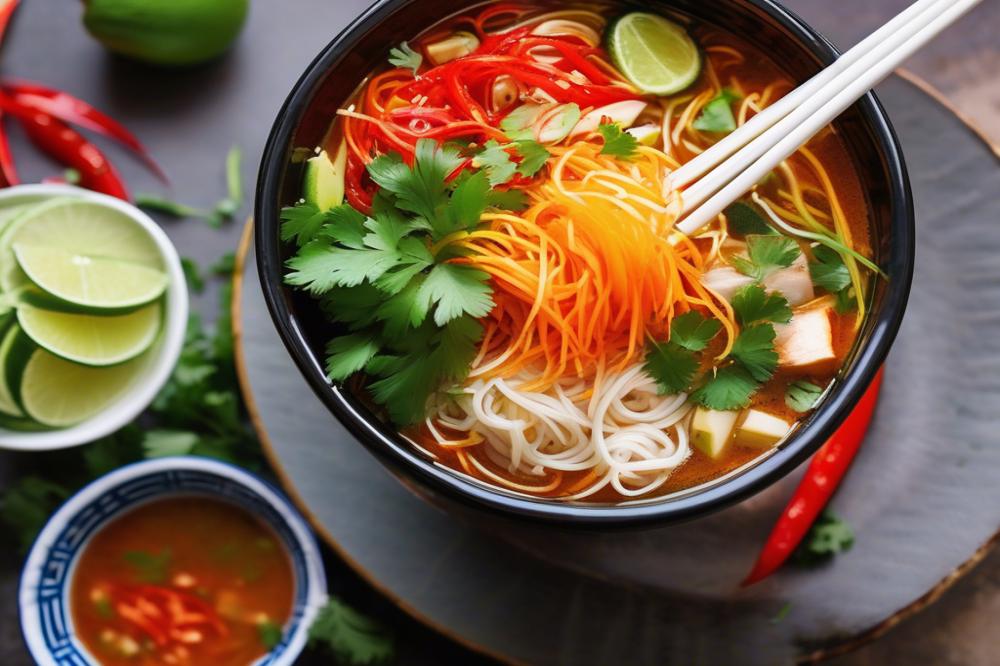
Selecting the Best Crab
Choosing fresh crab is essential in making flavorful crab soup. Look for crabs that move actively and have a clean ocean smell. If possible, buy crabs from a reputable market. Live crabs are often best, but if you get pre-cooked, check for bright color and firm texture. Blue crabs are typically preferred, but any sweet, tender variety can work for your bún riêu recipe.
Enhancing the Broth’s Flavor
Developing a rich broth can elevate your noodle soup. Start with water and simmer it with crab shells and other aromatics. Using ingredients such as ginger, onion, and garlic adds depth. Don’t forget to include tomatoes for acidity. Their unique flavor balances the sweet notes of the crab. Adding a bit of fish sauce can also contribute to the umami experience, tying the entire dish together beautifully.
Suggestions for Customization
Every cook can put their spin on this traditional Vietnamese food. Consider adding various seafood like shrimp or fish for extra flavor. Different vegetables, such as bean sprouts or bok choy, can enhance the nutrition and texture. Tailoring the ingredients makes it your own. Feel free to adjust the flavors and textures based on preference. A touch of chili can also bring a delightful kick.
The Importance of Serving Garnishes
Serving garnishes can significantly enhance your dish’s flavor and texture. Fresh herbs, such as basil and cilantro, brighten the soup. Lime wedges offer acidity to balance the richness. Slices of chili pepper can add heat for those who love spice. Other toppings like fried shallots add crunch and aromatic qualities. These elements are not mere decorations; they play a vital role in creating the complete experience of homemade soup. Each adds a different layer, making every spoonful exciting and comforting.
The Cultural Context of Bún Riêu Cua
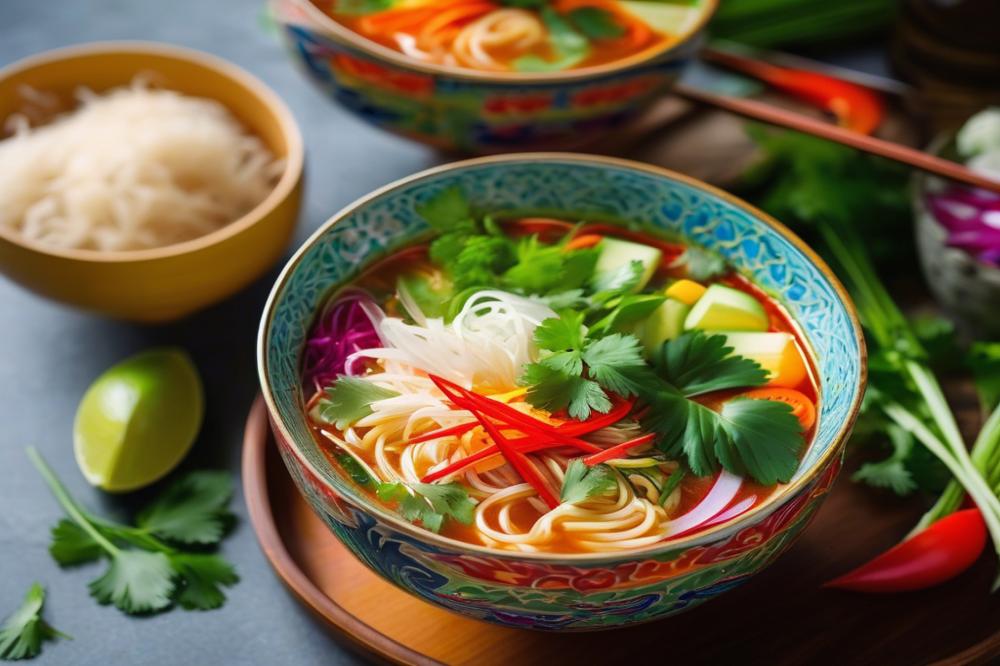
Bún Riêu Cua has a rich history within Vietnamese cuisine. This crab soup originated in the northern areas of Vietnam, especially in the bustling city of Hanoi. Over the years, it has evolved from humble beginnings into a beloved dish found across the country. Traditional recipes might vary, with different regions adding their own special touches. This noodle soup reflects the local culture and ingredients, showcasing the blend of flavors central to Vietnamese cooking.
Family gatherings often feature this comforting dish. Special occasions, like celebrations and holidays, bring people together to enjoy homemade soup. Its preparation can be a communal activity, where family members work together to create the perfect bowl. Sharing a meal of bún riêu underscores the importance of connection and warmth among loved ones. This practice highlights how food brings joy and comfort in Vietnamese culture.
In comparison with other types of seafood soup, bún riêu stands out. While traditional Vietnamese food commonly includes various dishes, few capture the harmony of flavors quite like this crab soup. Other seafood recipes might focus on fish or shrimp, yet bún riêu brings the distinctive taste of crab to the forefront. Cooking tutorials often include it alongside pho, showcasing both as staples of Vietnamese cuisine.
The delicate balance of ingredients in bún riêu adds to its charm. Many appreciate its bright flavors and the combination of fresh herbs. Its popularity makes it an approachable dish for those interested in Asian recipes. For home cooks seeking comfort food, this dish remains a reliable choice. Preparing a bún riêu recipe can be a rewarding experience, evoking warmth and nostalgia with each bite.
Final Thoughts on Cooking Bún Riêu Cua
Bún Riêu Cua stands out as a cherished gem in the diverse world of Vietnamese cuisine. This delightful dish combines fresh flavors and hearty ingredients. The taste of the vibrant broth and the richness of the crab create a meal that satisfies both hunger and the soul. Families often gather to enjoy this soup, making it a staple in Vietnamese culinary traditions.
Trying your hand at making this crab soup in your own kitchen may feel daunting. Yet, the effort will be rewarded with a warm bowl filled with flavors that transport you to the heart of Vietnam. As you chop, simmer, and season, each step allows you to connect with the essence of this beloved dish. The process itself can be incredibly fulfilling.
Embracing homemade cooking can be an adventure. It opens doors to explore different cultures and customs through food. Each time you prepare a dish like this, you’re not only creating a meal but also honoring a rich heritage. So, why not gather the ingredients and start your culinary journey? You might find that cooking is a wonderful way to bring joy and creativity into your life. Enjoy every steaming bowl and discover what makes Vietnamese flavors so special.

